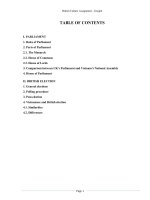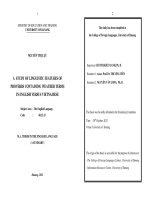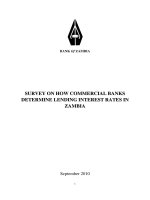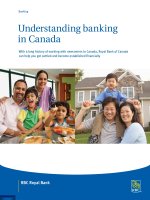Key terms in insurance docx
Bạn đang xem bản rút gọn của tài liệu. Xem và tải ngay bản đầy đủ của tài liệu tại đây (149.52 KB, 4 trang )
No Definition Example/Related terms
1 Risk: uncertainty, unexpectation
(1) the possibility of an unfortunate occurrence
(2) uncertainty of loss
(3) the possibility of loss
(4) unpredictability – the tendency that actual results may differ from
predicted results
Common factors:
- uncertainty referring to the future
- different levels of risk
+risky – heightened possibility
+frequency and severity
-> low severity with high frequency
high severity with low frequency
- resulting in unfavorable outcomes
Peril: in particular- the prime cause
If a house burns down, then fire is the peril
Hazard: factors influencing the outcome
Gas furnaces are a hazard for carbon monoxide poisoning.
Speculative risk: where there is the chance of gain
such as investing in the stock market, to make a profit; otherwise, a
person can avoid most speculative risks simply by avoiding the
activity that gives rise to it
Pure risk: involve a loss, at best a break-even situation
if your car is stolen, that is a direct loss; if you have to rent a car
because of the theft, then you have some financial loss—a
consequential loss—from renting a car.
2 Risk Management:
• Avoiding risks
• Preventing risks
• Minimizing risks
• Financing risks
• Financing risks
- Saving or reserving
- Borrowing (after loss occurred)=> self insurance
- Transferring:+ Insurance
3 Insurance: a risk transfer mechanism by that the insured can transfer
the financial consequences of the risk to the insurer, in return for
paying a premium.
-Indemnity: restore the financial situation before loss happened and
peace of mind
-Saving and investing=> financial intermediates
-loss control => reduction in the economic waste
- Business insurance
*Subject matter of insurance:+ property Ins+ liability Ins+ personal
Ins
*History of insurance:+ maritime Ins+ non maritime Ins *Technique
of insurance:+ non life Ins(general Ins)+life Ins
-Social security
4 Premium: is the price of ins product, is paid before indemnity is paid P = f + d, in which P: ins premium, d: added premium
f: pure premium (or indemnity premium)
5 The law of a large number: is a technical tool of calculating the
premium
6 Reinsurance: is the insurers insure the risk again
7 Coinsurance: is one method of sharing large risks, commonly used in
property insurance, rarely used in liability and personal insurance
-the sum-insured is shared by several different policies
Disadvantage: complex for the insured to make claim
8 Insurable Risks
*Fortuitous loss- an insurable event must be entirely fortuitous- 0 <
PoL < 1
*Homogenous exposures- have a large number of similar exposures.
Why???
- to forecast the expected extent of loss
=> to calculate required premium
*Financial measurement
- Loss could be: property, health or death
- Insurance does not remove risk. It provides financial compensation
for loss=> loss must be measured in term of money
*Pure risks, not speculative risks
*Public policy
- insurable risks must not be contrary to social and moral standards
*Not sustainable losses due to disasters (earthquake, nuclear…)
- difficult to cover losses in the case of disasters
- difficult to forecast PoL and calculate premium
=> Depreciation, purposeful acts?
=> The risk of death?
- example: theft, steal
9 Insurable Interest
Insured must have an insurable interest to the subject-matter of
insurance=> Insured may suffer financial losses if the risk happens
- In property ins: owners, borrowers and others
(Examples: shoe repairers, watch repairers…)
- In life ins:
+ an unlimited insurable interest in his/her own life
+ an insurable interest in his/her spouse
+ a limited insurable interest in his/her children
it is possible to insure the life of someone who owns another person
money until the loan is repaid
10 Utmost good faith
*Insurers:- must give truthful answers asked by the insured
- must give a truthful statement- keep clients’ information in secret
*Insured:- has a duty to disclose material facts
=> material facts is the information the insurer requires to be told about
Duty of disclosure: for general ins: it exists in the whole of the ins
period=> the insured has a duty to disclose any change related o the
subject matter of ins
- for life ins: the duty of disclosure just exists at the point when the
contract is taken out
Example of material facts:
A house insurance: its age, brick or timber built
A person
A car insurance
11 Indemnity:
for the purposes of insurance contracts, may be look upon * Principle: - total amount of indemnity is not excess
as exact financial compensation sufficient to place the insured in the
same financial position after a loss as he enjoyed immediately before it
occurred
*How to provide an indemnity:- cash payment- repair -
replacement
=> which method is common?
+ property ins: sum-insured and real value of losses
=> insurance value and sum-insured
+ liability: the limit of indemnity
+ personal insurance (benefit policies):the limit of indemnity
12 Average clause: Applying in underinsurance (sum insured < value
insured)
Amount of claim payment = (Sum insured/ Value of property at risk) x
Loss
A car policy with an excess of $100, i.e: The insured pays the first
$100 of any claim for damage to his car. Loss = $700; amount of
indemnity = 700 – 100 = $600.
Loss = $80 => amount of payment = 0
13 Excess clause: is the amount of each and every claim which is not
covered by the policy.
=> the insured does not receive a full indemnity from the insurer.
-Excess may be voluntary or compulsory.
Voluntary => Reduction in premium associated with the excess.
Compulsory => No corresponding reduction in premium.
A car policy with an excess of $100, i.e: The insured pays the first
$100 of any claim for damage to his car. Loss = $700; amount of
indemnity = 700 – 100 = $600.
Loss = $80 => amount of payment = 0
14 Franchise
a rather like an excess, applying for small losses.
Difference between an excess and a franchise: Once the franchise has
been exceeded, the claim is pay in full. (With an excess, the amount of
the excess is deduct from each and every claim)
E.g: Franchise: $20; Loss : $80; Payment = $80
Excess: $20; Loss: $80; Payment = $60
15 Deductible: The name given to a very large excess.
Apply for Large commercial insured => reduction in premium
E.g: An industrial insured choose a deductible of $100,000. Loss:
$300,000 => Amount payment : $200,000
16 Subrogation: is the right of one person, having indemnified another
under a legal obligation to do so, to stand in the place of that other and
avail himself of all the rights and remedies of that other, whether
already enforced or not.
17 Contribution: is the right of an insurer to call upon others similarly to
share the cost of an indemnity payment.
The case of dual insurance (there are more than one policy cover a
particular loss)
18 Proximate cause: the active, efficient cause that sets in motion a train
of event which brings about a result, without the intervention of any
force started and working actively from a new and independent source.
=> Proximate cause refers to dominant cause; there is direct link
between the cause and the result.
19 Proposal: the questionnaire of proposed risks
-expressing the proposer’s will to reach an insurance contract
-supplying info to evaluate the proposed risks.
Main content: subject matter and risk description
-structure:4 parts: general questions; specific questions related to the
proposed risks; commitments; warning
20 Policy: the evidence in writing of an insurance contract
Structure logical structure, standard grammar rules, simple words, clear
language
21 Cover notes: temporary certification of insurance commitment btw 2
parties. Getting after considering proposal carefully and paying
premium
The effect: temporary(30 days), all claims belong to insurer’s
responsibility
22 Managing ins. Contract: Payment of premium-addition &
modifications-Renewals-assignment-handling of insurance claims-
dispute-suspension and cancellation
23 Non-life Insurance (General Insurance)
Property Insurance
Liability Insurance
General Personal Insurance
24 Property insurance
An individual (a family, an organization) has many types of property
that can be damaged, be lost.
Variety of property insurance products :
Fire insurance-Goods in transit insurance-Air plane insurance-Money
insurance-Theft insurance-Glass insurance
“ Fire” Insurance
Subject to certain exclusions, most insurers’ fire policies cover: Fire-
Lightning-Explosion
For insured fire damage to occur:
-There must be actual fire or ignition in which.
-Something must have been on fire which ought not to have been on
fire.
-The fire must be accidental or fortuitous in origin.
-The insured property must be damaged as a result of fire.
Insurers’ liabilities:
-Pay to the insured the value of the property at the time at its loss or
destruction or the amount of the damage.
-At its option, will reinstate or replace such property or any part of it.
25 Liability Insurance: A person (an organization) may be liable to pay
damages to someone who suffers any injury or loss that they can prove
resulted from the person’s negligence.
Negligence: lack of care
Various liability insurance products: Motor’s third party liability-
Motor vehicle Policy
PART A: INSURED VEHICLE COVER
Cover any loss of, or damage to the vehicles and to its spare parts and
accessories while they are on the vehicle.
PART B: LIABILITY TO THIRD PARTIES
Employer Liability-Product Liability-Public-Liability-Professional
liability
-The insurer provides indemnity against third party claims arising out
of death or injury or damage to their property.
-Indemnity is often limited at an amount.
PART C: OTHER BENEFITS
1. Accidental Death of Permanent Disability
2. Medical Expenses
3. Legal Defense Cost
26 General Personal Insurance: Insurance of the persons against
personal accident, sickness…
Many types of personal insurance: Personal accident-insurance-Health
insurance-Traveler’s insurance
Travel Insurance
Normal Cover:
Medical, surgical, hospital and emergency dental expenses, either to a
particular limit or with no limit.
Death or permanent total disablement by accident.
Recover of prepaid fare, accommodation expenses, lost deposits.
Personal baggage up to a defined limit per insured person.
Personal liability, either unlimited or to a defined limit.
Premium factors:
The period of cover (usually in days)
Medical limit required
Additional cover
27 Term life insurance: Time of insurance is a specified number of years
(term).
Term life insurance only provides a protection.
Renewable term insurance: gives the policy owner the option to renew
the term insurance at the end of the term, generally without having to
submit evidence that he remains insurable.
Convertible term insurance: gives the insured or policy owner the right
to exchange (convert) the term insurance to a permanent plan of
insurance, again, without to provide evidence that the insured is an
insurable risk.
Level term insurance: Provides a death benefit that remains the same
over the term of the policy.
Decreasing term insurance: The amount payable decreases over the
term of coverage. The death benefit begins at a set amount and then
decreases over the term of coverage according to some stated method
described in the policy.
Mortgage redemption insurance: designed to provide a death benefit
that corresponds to the amount owned on home mortgage.
Credit life insurance: designed to pay the balance due on a loan if the
borrower dies before the loan is paid.
Family Income Coverage: provides a stated monthly income amount to
the insured’s surviving spouse if the insured dies during the term of the
coverage. Benefits continue until the end of the term specified when the
coverage was purchased.
Increasing term insurance: provides a death benefit that starts at one
amount and increases by some specified amount or percentage at stated
times over the policy’s term.
+Initially, premiums are generally lower than those for permanent
insurance, allowing you to buy higher levels of coverage at a younger
age when the need for protection often is greatest.
It's good for covering specific needs that will disappear in time, such
as mortgages or car loans.
+Premiums increase as you grow older.
Coverage may terminate at the end of the term or may become too
expensive to continue.
Generally, the policy doesn't offer cash value or paid-up insurance.
28 Whole life insurance
Permanent life insurance products offer lifetime coverage, and
Permanent life insurance products provide insurance coverage and
contain a savings element. Term insurance usually provides only
insurance protection.
Life rates are based on gender.
Death benefits: Fixed level. Cash value: Guaranteed amounts.
Premiums: Fixed level. Policy loans: Allowed. Partial withdrawals: Not
allowed. Surrender charges: None.
Includes Straight life, Limited-payment life, Single-premium life,
Investment Aspects
-Peace-of-mind: no matter when the insured dies , it will guarantee
the cost for funeral,…
-disciplined saving, tax-free growth( in some countries )=>
beneficiaries can usually receive the proceeds of life insurance
-protection from creditors
29 Universal life insurance
• Cash value is credited each month with interest
• The policy is debited each month by a cost of insurance
charge
Flexible premiums: change the amount of premium periodically.
Discontinue premium and resume them at a later date without lapsing
the policy.
Change the amount of death protection.
Death benefits: Level or increasing.
Cash value: Guaranteed minimum cash value plus additional interest
when rates are higher than guaranteed.
Policy loans: Yes, but the interest credited to the account is reduced.
-These loans require interest payments paid to the Insurance Company
Repayment of the loan principal is not required while payment of the
loan interest is required. Payment or non payment against them won’t
affect the policyholders’ credit rating. Outstanding loans will be
deducted from the death benefit at the death of the insured
-premium flexibility
-adjustable death benefits
The premiums are flexible, from a minimum amount specified in the
policy, to the maximum amount allowed by the contract
The death benefit can be increased (subject to insurability) or
decreased at the policy owner's request.
-Transparency to policy holders: Annual report of disclosure
statement
Population structure: large and young: 85 mill + each 1 mill
increase per year,60% population in labor force
Increasing education level: 52 millions - are youth, possessed of
traditional fondness for learning. High requirement of well-educated
employees
The saving lifestyle and saving behavior: High rate of saving per
earning
The changing of attitude into independent funds resources after
retired
Partial withdrawals: allowed. Surrender charges: Yes.
-Subject to contingent deferred sales charges, may also have additional
fees defined by the contract
-Taken out premiums first and then gains, so it is possible to take a tax
free withdrawal from the values of the policy
-The cash values removed by loan are no longer earning the interest, so
the cash values won’t grow as expected
The changing of earning level: Increasing of middle-earning
population level
Expected return of 1000$ due to 2010
+The overall Insurance legal framework is not completed yet, and
cannot satisfy the demand of insurance services.
30 Variable life insurance
-Death benefits: Guaranteed minimum plus increases from investments
-Cash value: Minimum not guaranteed, depends on investment
performance.
-Premiums: Fixed level. Policy loans: Yes. Partial withdrawals: Not
allowed. Surrender charges: Yes.
-Variable Life Insurance provides permanent protection to insured
beneficiary upon your death.
-It allows insured to allocate a portion of their premium dollars to a
separate account comprised of various investment funds within the
insurance company's portfolio, such as an equity fund, a money market
fund, a bond fund, or some combination thereof.
-Variable is a form of whole life insurance and because of investment
risks it is also considered a securities contract and is regulated by the
securities and exchange commission (SEC) and must be sold with a
prospectus.
Pros of this product:
◦ In term of insured:
Allow insured widens investment options
Tax advantage: income from investment is not taxable. Death benefit
has tax incentive when death occurs.
Allow insured to change investment portfolio for certain times
without charging more.
◦ In term of insurer:
Insurance company can transfer investment risk to insured.
Return is higher than traditional products because of lower reserve
requirement.
Variable life insurance has lower asset management → higher rate of
return
31 Variable Universal life insurance
Variable Universal Life (VUL) Insurance is a policy that combines:
- the premium and death benefit flexibility of universal life
- the investment choices of variable life
Flexible investment: Option to invest in their preferred investment
portfolio
Option to switch between the investment fund
options
Death benefits: Fixed
Cash value: Guaranteed minimum plus excess interest (like universal
life).
Premiums: Vary according to experience, but no higher than a set
maximum.
Policy loans: Yes. Partial withdrawals: allowed. Surrender charges:
Yes.
Strengths:
Transparency: the insurance company has to disclose the
information about the performance of portfolio.
Separate accounts protect insured in the event of the
insurer’s insolvency.
Withdraw cash value as policy loans without tax penalties.
32 Endowment life insurance:
Protection: The insured dies during the policy term
è
Pure risk cover
Saving: The insured remains alive beyond the policy term
è
Get back
the sum assured. A portion of premium goes to a cash value account
with interest, tax-deferred
Provide a specified benefit amount whether the insured lives to the end
of the term of coverage or dies during that term.
Specify a maturity date: on which the policy’s face amount will be paid
to the policy owner.
If the insured dies before the maturity date, the policy’s face amount is
paid to the designated beneficiary.
-Premiums are usually level throughout the term of the policy.
-Steady build up of cash values.
-Contains both a savings element and a protection.
-Can have surrender value.
Main subject : Children
Reasons:
- Vietnamese people’s custom
- Ensuring a stable financial status in case risks occur, also provide
savings
- Rest assured about unexpected risks:
àPay the sum insured to help maintain the family’s living standards
and the child’s studying.
àWaive all premiums for the remaining term of the policy.
àContinue to pay all the other insurance benefits as promised.
Subject: Retirees
Seeking to supplement pensions, besides receiving pensions under the
regime of the State è maintain a better standard of living after
retirement
Several employees out of the payrolls of state à no social insurance
regime è no pensions after retiring.
Have sufficient retirement but the payment compulsory social
insurance period is under 20 years (according to the Social Insurance
Law) is not enough Conditions for continuing participation to social
insurance è No pensions received
• Bring protection for kids’ education
• Accumulated dividend + terminal bonus









